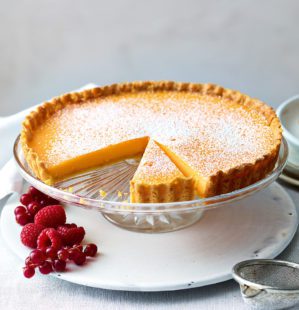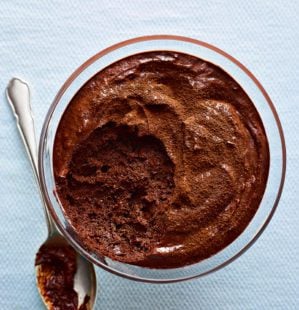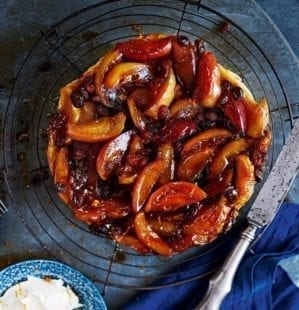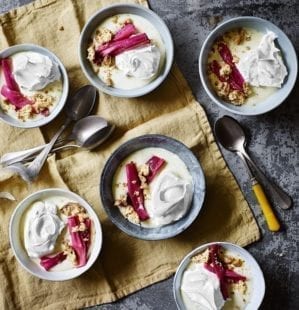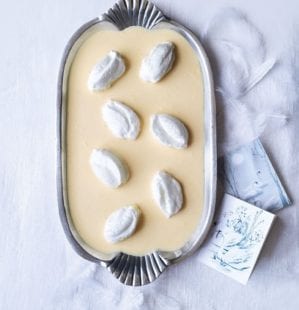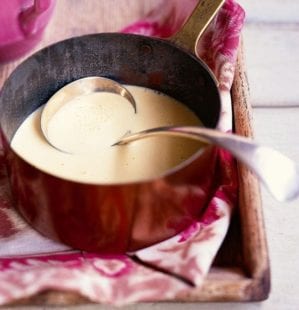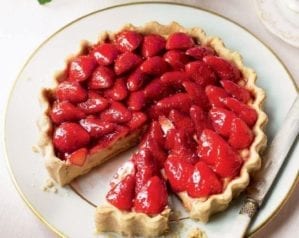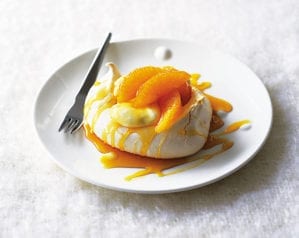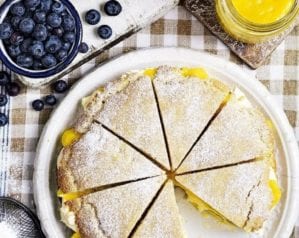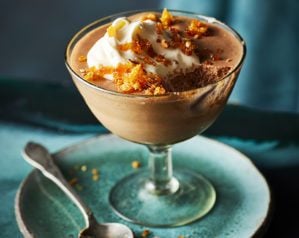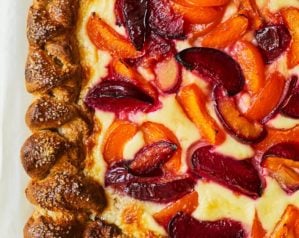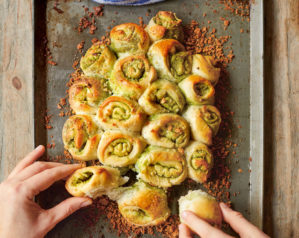
Michel Roux Jr’s Îles flottantes
- Published: 14 Jun 22
- Updated: 20 Sep 24
You’re in for a treat with this classic dessert which sees a perfect custard, topped with meringues then covered in caramel. How you flavour the custard is up to you!
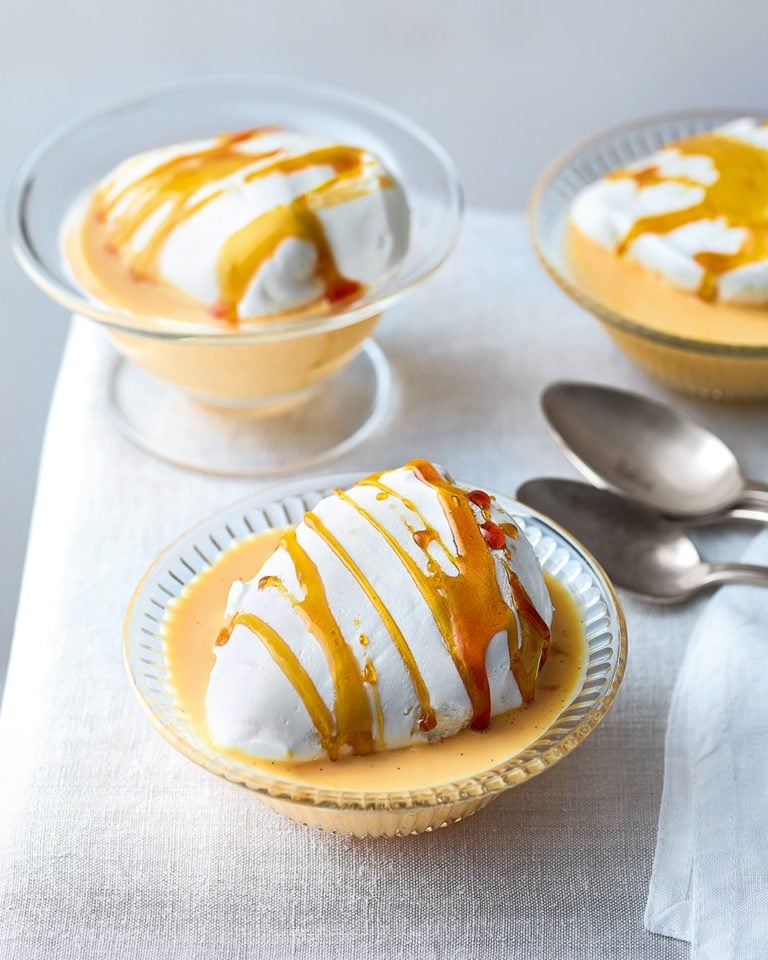
“At the old Le Gavroche, when my father and uncle first opened, they would serve desserts on a trolley and there were always floating islands in a big silver bowl – a mountain of caramel and meringues the maître d’ would spoon out ceremoniously to serve.”
Michel Roux Jr began his career with a patisserie apprenticeship in Paris. For nearly 30 years he’s been chef-patron of two-Michelin-star restaurant Le Gavroche, opened in 1967 by his late father Albert and uncle Michel Sr. He also oversees the food at London hotel The Langham and teaches at its cookery school, Sauce by The Langham. Michel Roux Jr’s classes are a chance to learn from the main man, while preparing a menu of his design.
-
Serves 4
-
Hands-on time 1 hour
Ingredients
For the meringue
- 6 free-range egg whites
- 180g caster sugar, plus 2 tbsp for poaching
For the caramel
- 200g caster sugar
For the crème anglaise
- 500ml milk
- 1 vanilla pod, split, seeds scraped
- 6 free-range egg yolks
- 80-120g caster sugar, depending on how sweet you like it
Method
- To make the crème anglaise, in a saucepan, bring the milk to the boil with the vanilla seeds and pod. Remove the pan from the heat, cover and leave to infuse for 10 minutes.
- Use a balloon whisk to beat the egg yolks with 80g of the sugar until thick and creamy. Bring the milk back to the boil and pour it onto the yolk mixture, whisking continuously.
- Pour the mixture back into the pan and cook over a low heat, stirring continuously with a spatula, until the custard thickens slightly (see Roux’s Rules). Don’t overheat or the custard will scramble. Strain through a sieve into a clean bowl, discarding the vanilla pod (wash and dry the pod and use to flavour sugar). Taste and adjust the sweetness with additional sugar, if you like, then cover with a sheet of baking paper touching the surface to prevent a skin forming. Set aside.
- For the meringue, beat the egg whites with an electric mixer until frothy, then add the sugar in 3-4 additions, beating well between additions. Continue to whisk until the meringue is firm, smooth and glossy, forming stiff peaks (see Roux’s Rules in tips).
- Bring a large wide pan of water, sweetened with the remaining 2 tbsp caster sugar, to a gentle simmer. Scoop out an island of meringue with a large spoon (see Roux’s Rules), then plunge the spoon into the simmering water. The island should come off the spoon and poach in the liquid. Flip it over after 2-3 minutes to cook on both sides. Continue until all the meringue is used (you should get 4 large islands). Once cooked, gently lift the islands out of the liquid with a slotted spoon and put them on a rack to cool and drain.
- To make the caramel, heat a heavy pan over a medium heat. Add the remaining 200g caster sugar and cook, stirring as needed, until the sugar melts (see Roux’s Rules). Increase the heat to medium-high and cook until the caramel turns golden brown.
- To serve, divide the vanilla crème anglaise among bowls. Top with a meringue floating island, then drizzle over the caramel. Serve straightaway.
- Recipe from June 2022 Issue
Nutrition
- Calories
- 640kcals
- Fat
- 13g (5.2g saturated)
- Protein
- 13.8g
- Carbohydrates
- 115g (115g sugars)
- Salt
- 0.4g salt
FAQs
How do I know when it has thickened enough?
When it coats the back of a spoon or spatula.
Can I rescue it if it starts to scramble?
Quickly pour it through a sieve into a bowl – that will bring the temperature down. If it’s still a little grainy, immediately whizz with a stick blender and it should come back to smooth.
Should I use older or fresher eggs for meringues?
Egg whites whip up better if they’re old, which is fine if you’re making meringue that’s cooked for hours in the oven, but for this recipe it’s better to use fresh and to make sure the meringue is whipped to stiff peaks.
How do I shape the floating islands?
Use big kitchen spoons or large serving spoons. Dip in water and take a big scoop. Don’t be too fussy. They can be freeform – like icebergs. They don’t have to be the perfect quenelle shape.
What should I look for when poaching the meringue?
The water should be barely simmering. It mustn’t boil. If it does, it will cook the meringue too quickly and it will collapse. It takes 2-3 minutes on each side. You’re looking for it to be sealed and firm to the touch.
’m nervous about making a dry caramel... Any tips?
Break down the lumps in your sugar when you pour it out of the packet and start on a moderate heat until the sugar starts to melt. You can stir it – there are recipes that say don’t, but you can – and be careful. It’s very, very hot.
How dark should it be?
The darker it is, the more bitter the caramel will be; a lighter caramel is sweeter, with less caramel flavour. Aim for a golden brown.
delicious. tips
You can make the dessert your own by putting pralines, chocolate or soft fruit in it… It’s great with fruit compote underneath as well.
Buy ingredients online
Rate & review
Rate
Reviews
Subscribe to our magazine
Food stories, skills and tested recipes, straight to your door... Enjoy 5 issues for just £5 with our special introductory offer.
Subscribe
Unleash your inner chef
Looking for inspiration? Receive the latest recipes with our newsletter

